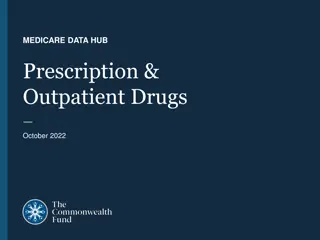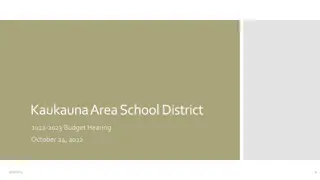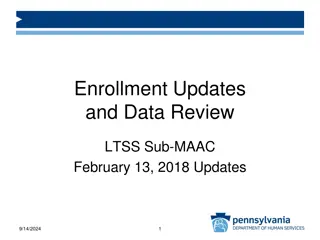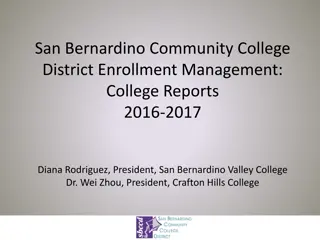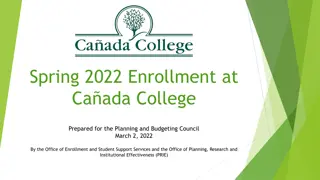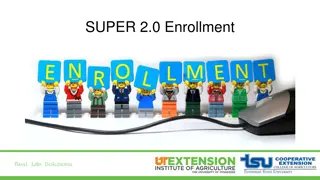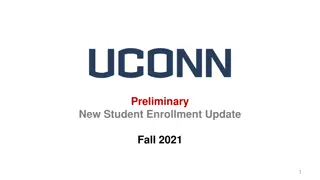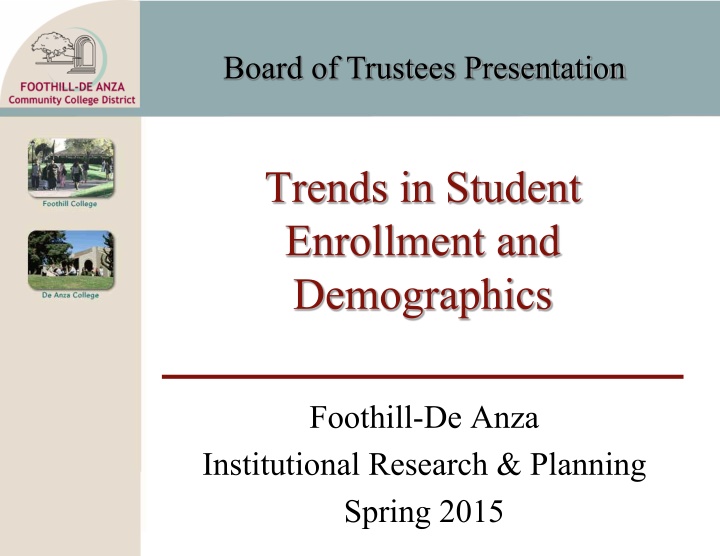
Student Enrollment and Demographic Trends Presentation Spring 2015
Explore the trends in student enrollment and demographics at Foothill-De Anza based on data from the Institutional Research & Planning department. Discover insights on enrollment by race/ethnicity, gender, full-time/part-time status, and age groups. Gain valuable perspectives on improvement strategies and outcome rates to understand the current reality and plan for the future.
Download Presentation

Please find below an Image/Link to download the presentation.
The content on the website is provided AS IS for your information and personal use only. It may not be sold, licensed, or shared on other websites without obtaining consent from the author. If you encounter any issues during the download, it is possible that the publisher has removed the file from their server.
You are allowed to download the files provided on this website for personal or commercial use, subject to the condition that they are used lawfully. All files are the property of their respective owners.
The content on the website is provided AS IS for your information and personal use only. It may not be sold, licensed, or shared on other websites without obtaining consent from the author.
E N D
Presentation Transcript
Board of Trustees Presentation Trends in Student Enrollment and Demographics Foothill-De Anza Institutional Research & Planning Spring 2015
Outline Part I: The data Enrollment What are the trends? What is (should be) our current reality? Part II: How to think about data Perspective on improvement strategies What s the problem with outcome rates?
Data Resources Program Review Active Division FHDA Research Website Factbook Fast Facts Strategic Planning Documents College Institutional Research Websites Completed Research Projects CCCCO Student Success Scorecard Data Mart
Outline Part I: The data Enrollment What are the trends? What is (should be) our current reality? Part II: How to think about data Perspective on improvement strategies What s the problem with outcome rates?
Enrollment Trends by Race/Ethnicity 40% 35% 30% 25% 20% 15% 10% 5% 0% F08 F11 F12 F13 Latino/a F14 African American Asian/PI Filipino White Fall 08 2,036 13,439 1,758 6,131 12,807 44,762 Fall 11 1,767 12,916 2,184 7,511 11,446 39,482 Fall 12 1,902 13,014 2,214 8,086 10,587 38,204 Fall 13 1,781 12,571 2,246 8,623 9,664 36,774 Fall 14 1,826 12,444 2,366 9,008 9,120 36,507 African American Asian/PI Filipino Latino/a White Total FHDA IRP
Enrollment Trends by Gender & FT/PT 51.0% 80% 60% 50.0% 40% 49.0% 20% 48.0% 0% F08 F11 F12 F13 F14 47.0% F08 F11 F12 Female F13 F14 Full-time Part-time Male Fall 08 22,089 19,451 18,551 18,109 18,089 22,645 19,724 19,371 18,430 18,160 28 307 282 Fall 11 Fall 12 Fall 13 Fall 14 Fall 08 Fall 11 Fall 12 Fall 13 Fall 14 Male Female Unrecorded Full-time 14,031 14,921 15,574 15,990 16,222 Part-time 30,731 24,561 22,630 20,784 20,285 235 258 FHDA IRP FHDA IRP
Enrollment Trends by Age Groups 50% 40% 30% 20% 10% 0% F08 F11 25 - 29 F12 F13 40 - 49 F14 19 or less 20 - 24 30 - 34 35 - 39 50 - 59 60+ Fall 08 13,629 11,883 5,791 3,185 2,327 3,507 2,159 2,271 Fall 11 8,769 14,050 5,583 2,986 1,969 2,799 1,908 1,409 Fall 12 8,651 14,627 5,242 2,707 1,642 2,471 1,631 1,229 Fall 13 6,896 16,359 5,457 2,550 1,482 1,948 1,321 761 Fall 14 7,122 16,284 5,483 2,480 1,452 1,821 1,141 724 19 or less 20 - 24 25 - 29 30 - 34 35 - 39 40 - 49 50 - 59 60+ FHDA IRP
Enrollment Trends by Enrollment Status 60% 50% 40% 30% 20% 10% 0% F08 F11 F12 F13 Returning Student F14 First-time Student Continuing First-time Transfer Special Admin (K-12) Fall 08 6,200 6,448 9,055 20,262 2,787 Fall 11 5,463 4,797 6,317 22,070 832 Fall 12 5,367 4,392 6,712 20,236 825 Fall 13 5,543 5,198 7,780 17,597 654 Fall 14 5,653 4,472 9,035 16,689 658 First-time Student First-time Transfer Returning Student Continuing Special Admin (K-12) FHDA IRP
Enrollment Trends by Online Ed. (FTES) & International 100% 100% 80% 80% 60% 60% 40% 40% 20% 20% 0% 0% F08 Foreign - F1 and Other Non-Foreign F11 F12 F13 F14 F08 F11 F12 F13 F14 Non-Online Ed. Online Ed. Fall 08 Fall 11 Fall 12 Fall 13 Fall 14 Fall 08 Fall 11 Fall 12 Fall 13 Fall 14 Non-Online Ed. Non-Foreign 41,878 36,068 34,526 32,917 32,456 10,710 8,995 8,654 8,518 8,510 Foreign - F1 and Other 2,884 3,414 3,678 3,857 4,051 Online Ed. 1,222 1,482 1,379 1,542 1,633 FHDA IRP CCCCO Data Mart
Enrollment Trends by City 50% 40% 30% 20% 10% 0% F08 San Jose Cupertino Santa Clara F11 F12 F13 F14 Sunnyvale Mountain View Palo Alto F12 F13 14,113 14,203 3,421 3,839 2,408 1,479 2,294 1,808 2,001 2,102 1,382 1,155 996 1,022 836 9,731 F08 14,316 4,436 3,238 2,915 2,294 2,298 1,616 960 984 11,705 F11 14,210 3,613 2,627 2,486 2,050 1,561 1,153 1,012 907 9,863 F14 14,321 3,905 1,361 1,648 2,170 1,108 606 849 774 9,765 San Jose Sunnyvale Cupertino Mountain View Santa Clara Palo Alto Los Altos/Los Altos Hills Fremont Milpitas Other 693 883 792 9,820 FHDA IRP
Enrollment Trends by City 45% 40% 35% 30% 25% 20% 15% 10% 5% 0% F08 San Jose Cupertino Santa Clara Los Altos/Los Altos Hills Milpitas F11 F12 F13 F14 Sunnyvale Mountain View Palo Alto Fremont FHDA IRP
Enrollment Projections by City All Ages Ages 15-30 35% 35% 30% 30% 25% 25% 20% 20% 15% 15% 10% 10% 5% 5% 0% 0% 2015 2020 2025 2030 2015 San Jose 2020 2025 Sunnyvale 2030 San Jose Sunnyvale Cupertino Santa Clara Cupertino Santa Clara Palo Alto Los Altos/Los Altos Hills Palo Alto Los Altos/Los Altos Hills Milpitas All other cities Milpitas All other cities 2015 2020 2025 2030 2015 2020 2025 2030 San Jose 12,954 13,560 14,194 14,858 San Jose 15,938 16,683 17,464 18,281 Sunnyvale 2,216 2,332 2,454 2,583 Sunnyvale 3,067 3,228 3,398 3,576 Cupertino 1,648 1,693 1,740 1,788 Cupertino 2,256 2,318 2,381 2,447 Santa Clara 1,576 1,657 1,742 1,831 Santa Clara 1,994 2,096 2,204 2,317 Palo Alto 1,294 1,338 1,385 1,432 Palo Alto 2,031 2,101 2,173 2,249 Los Altos/Los Altos Hills 473 482 491 500 Los Altos/Los Altos Hills 802 818 833 849 Milpitas 765 826 892 963 Milpitas 892 963 1,040 1,123 All other cities 9,128 9,396 9,671 9,955 All other cities 11,910 12,259 12,617 12,985 Hanover Report Hanover Report
Enrollment Projections by City All Ages Ages 15-30 35% 35% 30% 30% 25% 25% 20% 20% 15% 15% 10% 10% 5% 5% 0% 0% 2015 2020 2025 2030 2015 San Jose Sunnyvale Cupertino Santa Clara Palo Alto Los Altos/Los Altos Hills Milpitas All other cities 2020 2025 2030 San Jose Sunnyvale Cupertino Santa Clara Palo Alto Los Altos/Los Altos Hills Milpitas All other cities Hanover Report Hanover Report
What Makes Sense for Foothill-De Anza CCD? Changes (percentage points) from F 08 F 14 Race/Ethnicity Asian: +4 Latino/a: +11 White: -4 Gender Very little change FT/PT Full-time: +13 Age Group 20-24: +18 19 or less: -10 25-29: +2 Enrollment Status Continuing: +1 Returning: +5 First-time Student: +1 Online Education D.E.: +6 International Foreign: +5 City San Jose: +7 Cupertino: -3 Mountain View: -2
Outline Part I: The data Enrollment What are the trends? What is (should be) our current reality? Part II: How to think about data Perspective on improvement strategies What s the problem with outcome rates?
YOUVE SEEN THE DATA: WHAT S THE NEXT STEP? HOW DO WE THINK ABOUT THE DATA?
An Equity Lens Access Who is enrolling on our campuses? Ensuring diversity Population projections Outreach Outcomes How are we serving our students? Are students achieving equal outcomes?
Measuring Student Outcomes Many indicators of student success Course success rates District Strategic Plan Student Equity Plan Institutional Goals (IEPI) Let s take a look .
Measuring Student Outcomes Foothill-De Anza Community College District Course Success Rates 100% 90% 80% 70% 60% 50% 40% 30% 20% 10% 0% Fall 2010 Fall 2011 Fall 2012 District Fall 2013 Fall 2014 CCCCO Data Mart
Measuring Student Outcomes Foothill-De Anza Community College District Fall 2014 Course Success Rates by Ethnicity 100% 90% achievement gap at 18% 80% 70% 60% 50% 40% 30% 20% 10% 0% District De Anza Asian Foothill African American Latino/a White CCCCO Data Mart
Measuring Student Outcomes Foothill-De Anza Community College District Course Success Rates 100% 90% 80% 70% 60% 50% 40% 30% 20% 10% 0% 2004-05 2005-06 Overall 2006-07 Prepared 2007-08 2008-09 Unprepared Student Success Scorecard
Measuring Student Outcomes Foothill-De Anza Community College District Completion/Student Progress and Attainment Rate (SPAR) 100% 90% 80% 26% gap 70% 60% 50% 40% 30% 20% 10% 0% 2004-05 2005-06 2006-07 Unprepared 2007-08 2008-09 Prepared Student Success Scorecard
HOW DO WE IMPROVE THE TREND? HOW DO WE MAKE DATA ACTIONABLE?
Improving Course Success Gap Increasing Growth Rising Tide Bottom-up Win-Win Gregory Stoup, Contra Costa CCD
Improving Student Outcomes Consider an equity approach that would move as many as possible toward course success Bottom-up Win-Win As opposed to focusing only on increasing course success among specific groups
Student Outcomes Rates: Language Review Math Language It s a fraction Bottom number (denominator) = total number possible Top number (numerator) = total number actual CC Language Still a fraction but presented as a percent Bottom number = # of students who could/want outcome Top number = # off students who achieve outcome Percent of students who achieve outcome.
Student Outcomes Rates: Problem? What s the problem? It s all about the denominator (could vs. want) What s the student s intent? Sometimes it s also about the numerator Do we even have good data? Example
Transfer Rates? 70% 2007/08 Cohort Completers Overall (Scorecard) Fall 2007 (Data Mart) Annual Headcount (Data Mart) Transfer Velocity Cohort (Data Mart) First-Time Students (Data Mart) 58% 60% 50% 40% 32% 30% 22% 20% 10% 4% 3% 0% Numerator is 1,930 (from Transfer Velocity Cohort) Annual Headcount Fall 07 Headcount First-time Students Completers Overall Transfer Velocity Cohort
Student Outcomes - Rates Other areas where rates are discussed Denominator issues (Retention Rates) Persistence Rates Completion Rates Transfer Rates Numerator issues CTE l Employment l Wage
Where do we talk about outcomes? Internally (to name a few) Institutional Plans (E.g. EMP) Program Review Research Requests Externally (to name a few) ACCJC Grants Institutional Effectiveness Partnership Initiative (IEPI)
Thank You Not everything that can be counted counts, and not everything that counts can be counted. - Albert Einstein






